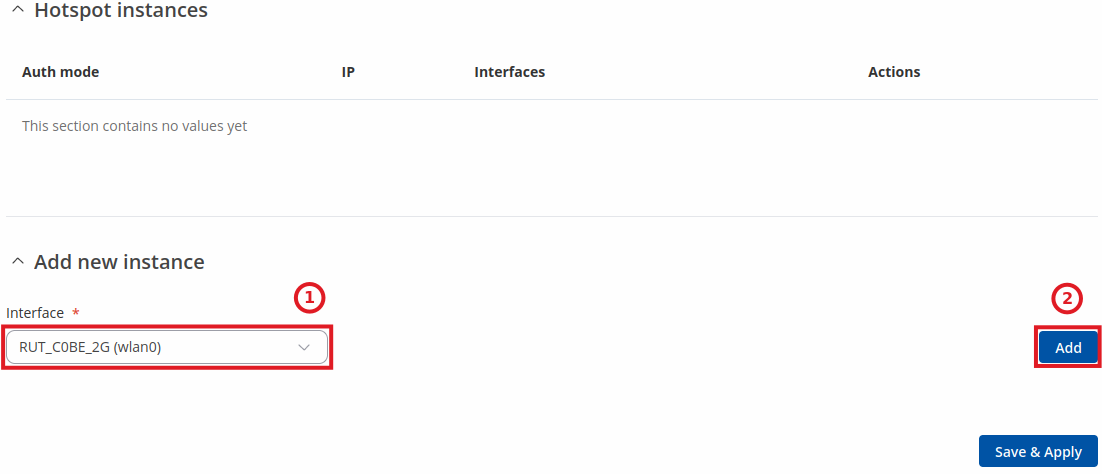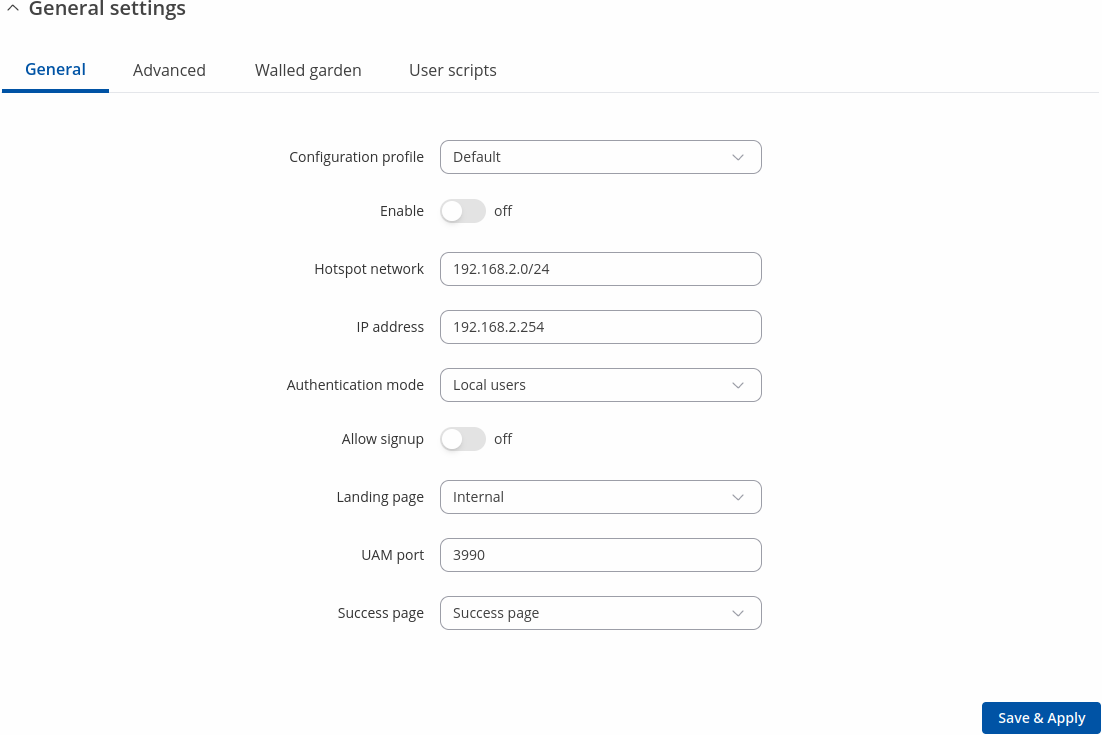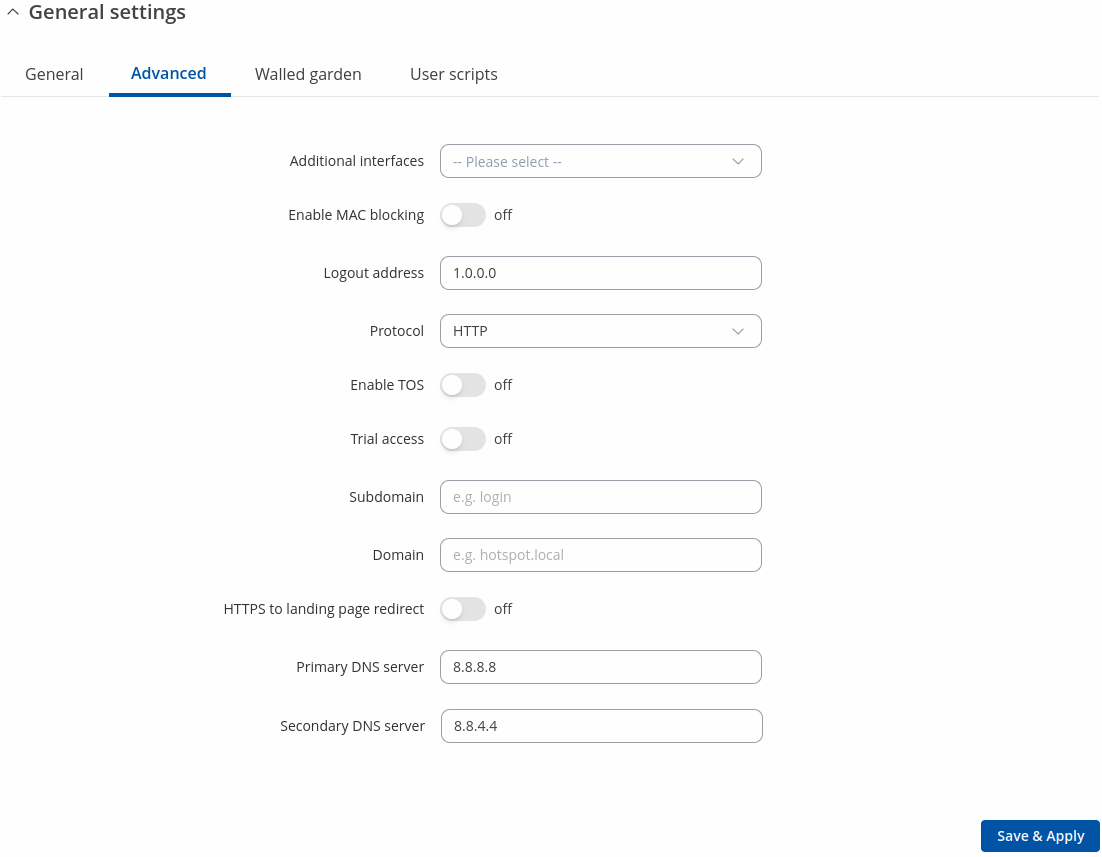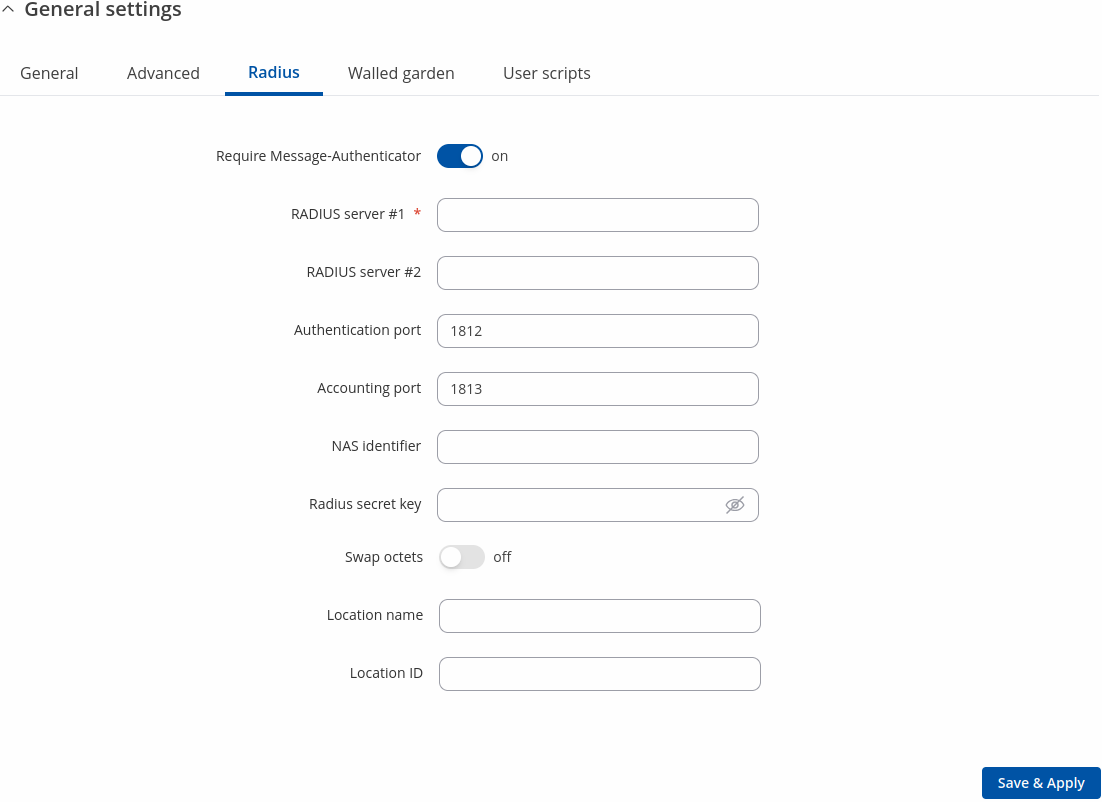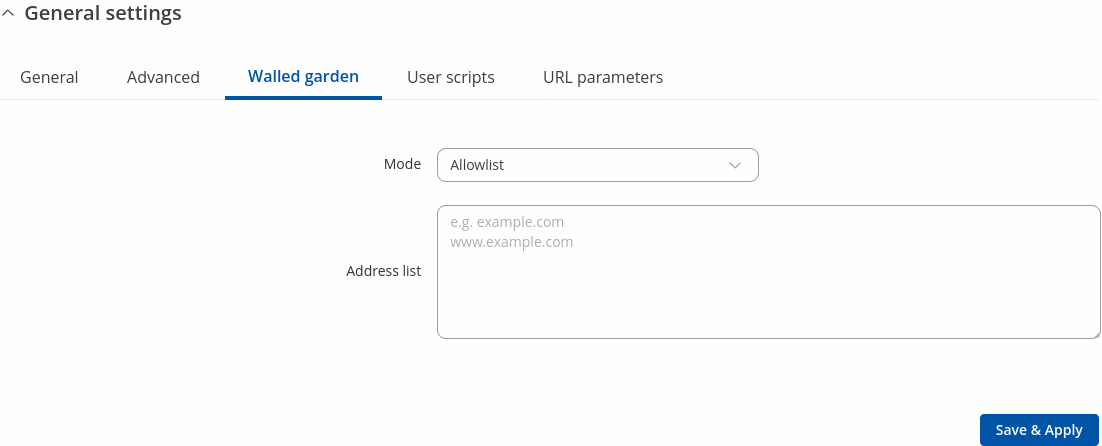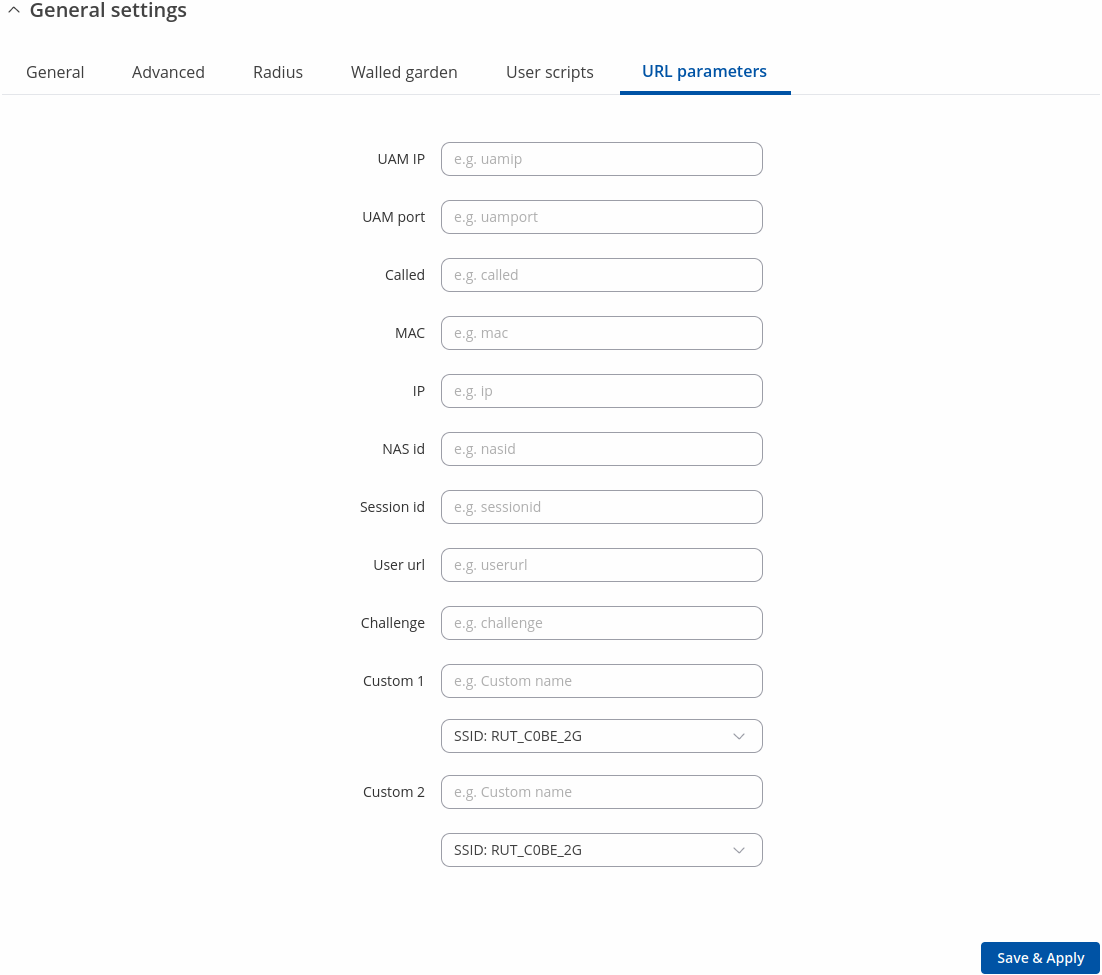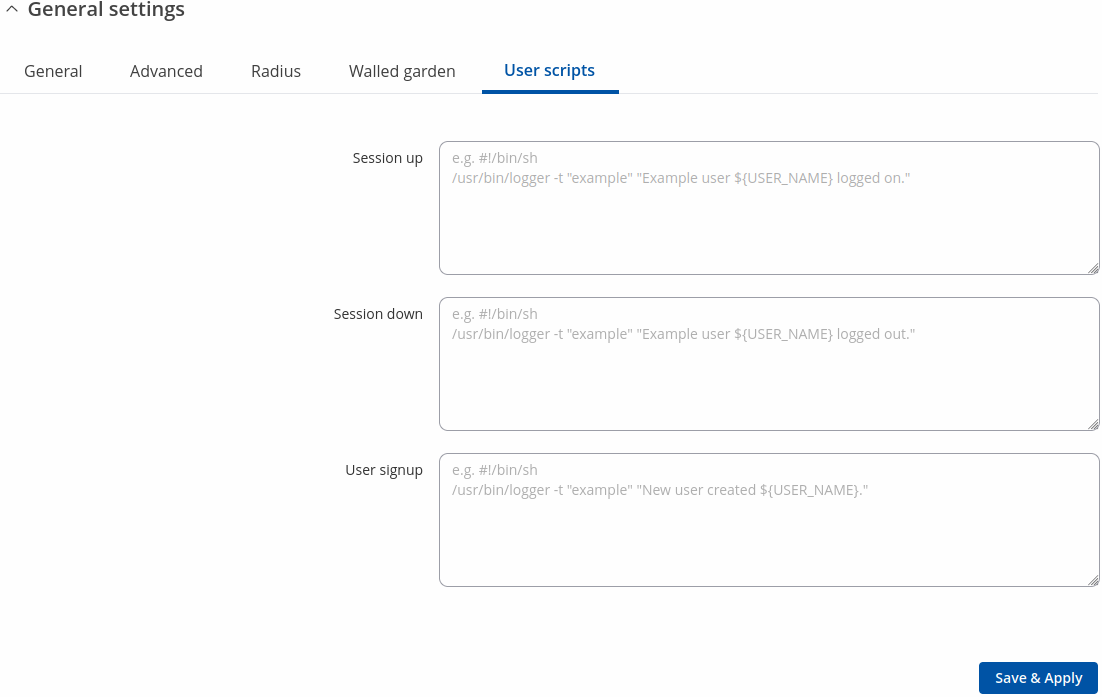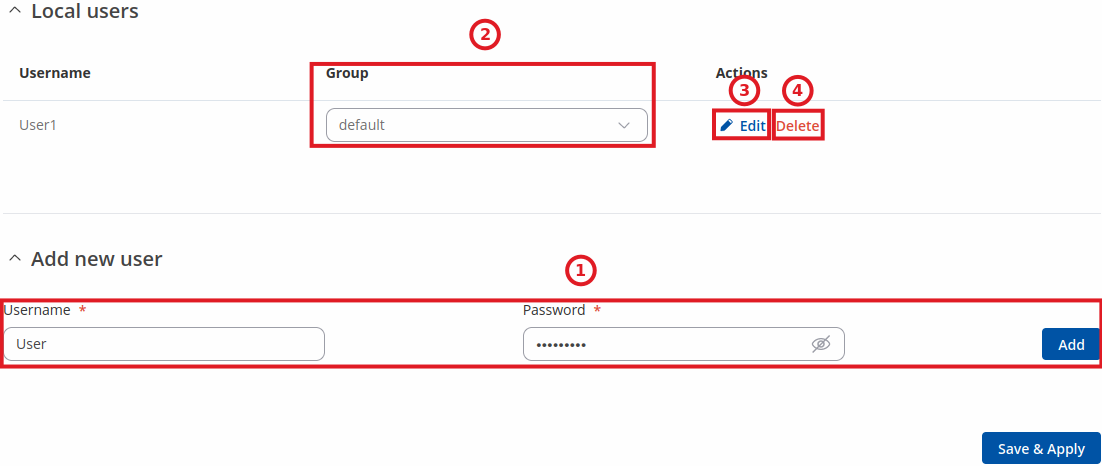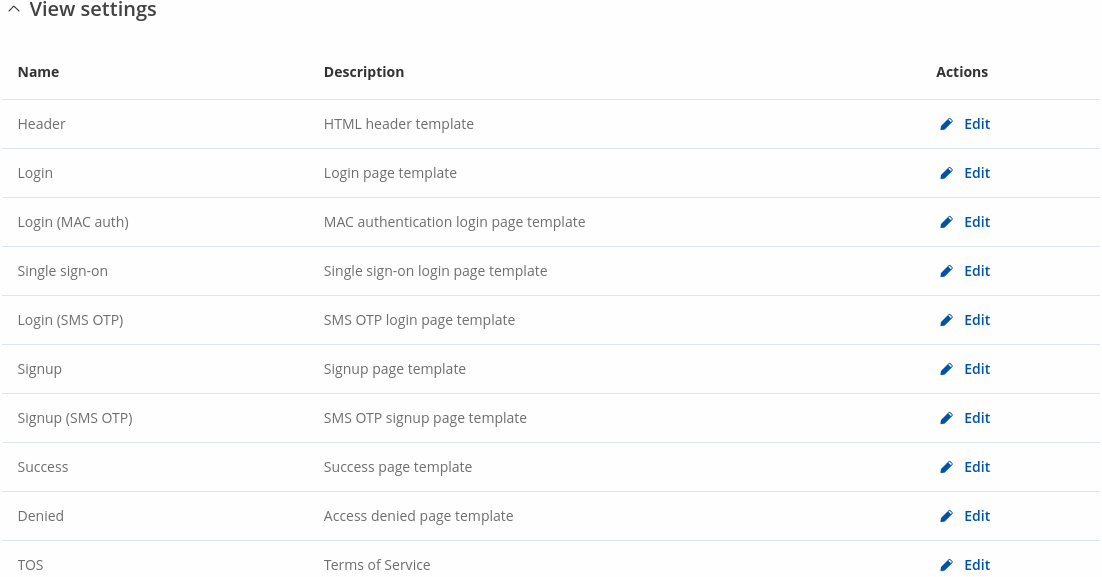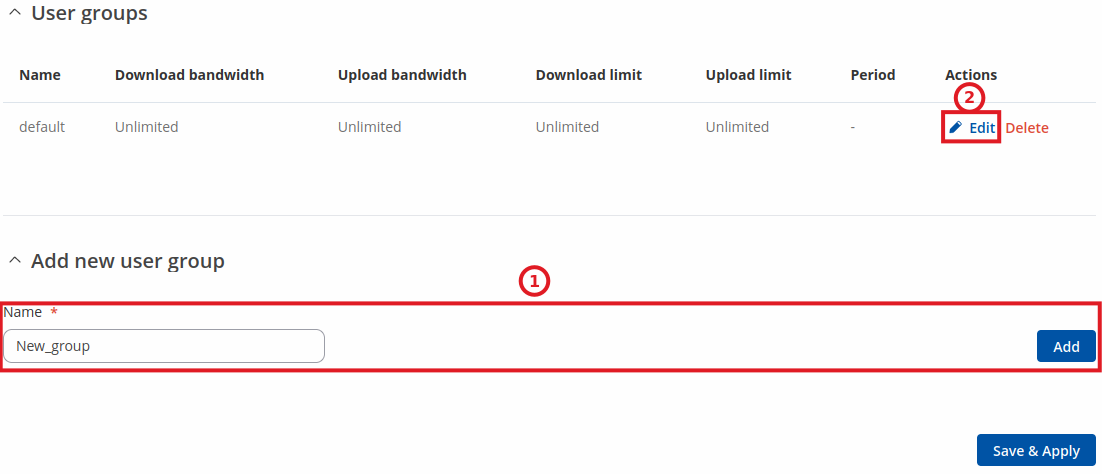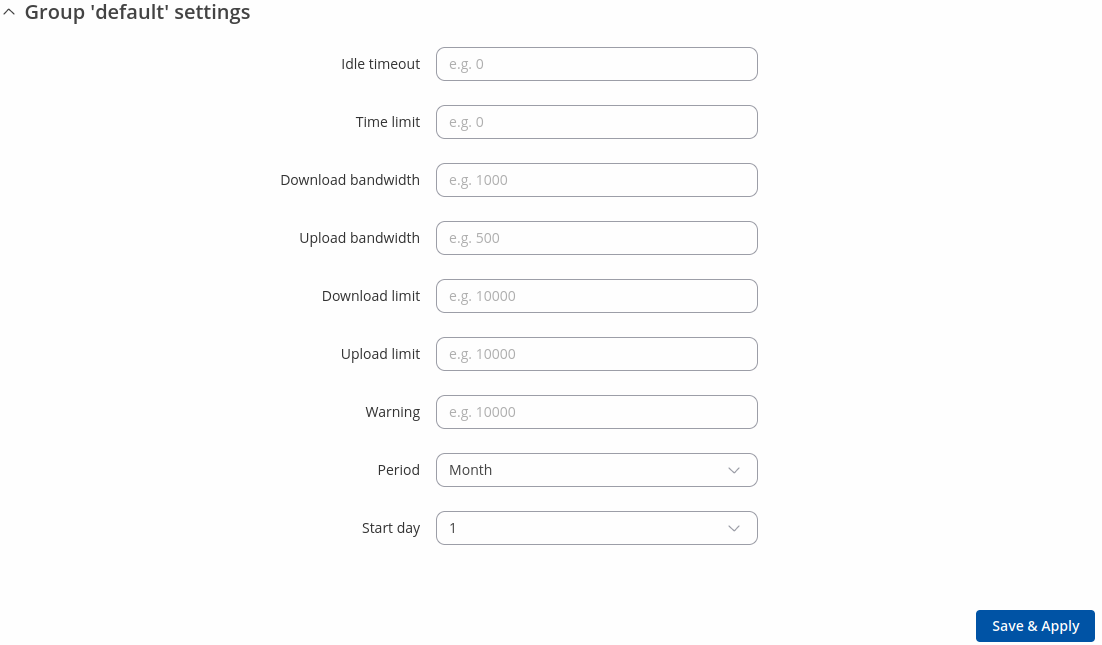RUT300 Hotspot
The information in this page is updated in accordance with firmware version RUT30X_R_00.07.14.4.
Summary
On Teltonika Networks devices a Hotspot is a service that provides authentication, authorization and accounting for a network. This chapter is an overview of the Hotspot section for RUT300 devices.
Note: Hotspot is additional software on some devices that can be installed from the System → Package Manager page.
General
Hotspot Instances
The Hotspot Instances section displays the main parameters of your Hotspot. By default, a Hotspot instance does not exist on the device. To create a new instance and begin configuration:
- select an 'Interface';
- click the 'Add' button;
After this, a new Hotspot configuration window will appear.
General Settings
The General Settings window is where most of the Hotspot configuration takes place. Look to the sub-sections below for information on configuration fields found in the General Settings sections.
General
| Field | Value | Description |
|---|---|---|
| Configuration profile | Cloud4wi | Default | Hotspotsystems | Purple portal; default: Default | Pre-configures Hotspot settings according to the selected service provider. |
| Enable | off | on; default: on | Turns the Hotspot instance on or off. |
| Hotspot Network | ip/netmask; default: 192.168.2.0/24 | IP address and subnet of the Hotspot network. Netmask must be from 16 to 30. |
| IP Address | ip; default: 192.168.2.254 | Defines the IP address of your Hotspot router in network. |
| Authentication mode | Local users | Radius | MAC authentication | Single sign-on; default: Local users | Authentication mode defines how users will connect to the Hotspot. |
| Local users: Allow signup | off | on; default: off | Allows users to sign up to hotspot via landing page. |
| Local users: Expiration time | integer; default: 0 | User credential expiration time. Applies to users who signed up via landing page. |
| Local users: Users group | user group; default: default | The user group to which users signed up via landing page should be assigned to. |
| Radius : Enable MAC authentication | off | on; default: off | Enable MAC address authentication. |
| MAC authentication: Require password | off | on; default: off | Enables password requirement for MAC authentication. |
| MAC authentication: MAC auth password | string; default: none | Password for MAC authentication. |
| MAC authentication / Single sign-on : User group | select; default: default | Specifies the group of dynamically created users. |
| Landing Page | Internal | External; default: Internal | Location of the landing page. |
| UAM Port | integer; default: 3990 | Port to bind for authenticating clients. |
| Password encoding | off | on; default: none | Password encoding with the challenge. |
| Landing page address | url; default: none | External landing page address (http://www.example.com). |
| UAM Secret | string; default: none | Shared secret between uamserver and hotspot. |
| Success page | Success Page | Original URL | Custom; default: Success page | Location to return to after successful authentication. |
| Custom | url; default: none | Address must contain protocol (http://www.example.com). |
Advanced
| Field | Value | Description |
|---|---|---|
| Additional interfaces | Available interfaces; default: none | Choose additional the interfaces you want to attach to this hotspot instance. |
| Enable MAC blocking | off | on; default: off | Blocks access to MAC addresses that have reached set amount of failed login attempts. |
| Logout address | ip; default: 1.0.0.0 | IP address to instantly logout a client accessing it. |
| Protocol | HTTP | HTTPS; default: HTTP | Protocol to be used for landing page. |
| Enable TOS | off | on; default: off | Enables Terms of Service (ToS) requirement. Client device will be able to access the Internet only after agreeing ToS. |
| Trial access | off | on; default: off | Enables trial internet access for a specific group. |
| Group | User group; default: default | Specifies the group of trial users. |
| Subdomain | string; default: none | Combined with Domain to make a DNS alias for the Hotspot IP address. |
| Domain | string; default: none | Combined with Subdomain to make a DNS alias for the Hotspot IP address. |
| HTTPS to landing page redirect | off | on; default: off | Redirect initial pre-landing page HTTPS requests to hotspot landing page. |
| Certificate files from device | off | on; default: off | Specified whether to upload key & certificate files from computer or to use files generated on this device via the System → Administration → Certificates page. |
| SSL key file | key file; default: none | Upload/select SSL key. |
| SSL certificate file | certificate file; default: none | Upload/select SSL certificate. |
| Primary DNS server | ip; default: 8.8.8.8 | Additional DNS servers that are to be used by the Hotspot. |
| Secondary DNS server | ip; default: 8.8.4.4 | Additional DNS servers that are to be used by the Hotspot. |
Radius
Radius authentication mode uses an external RADIUS server, to which you have to provide an address to, instead of using the router's Local Authentication. If you are using Local authentication, this section is not visible.
| Field | Value | Description |
|---|---|---|
| Require Message-Authenticator | off | on; default: on | Require and validate Message-Authenticator RADIUS attribute on Access-Request replies. |
| RADIUS server #1 | ip; default: none | The IP address of the RADIUS server #1 that is to be used for Authenticating your wireless clients. |
| RADIUS server #2 | ip; default: none | The IP address of the RADIUS server #2 that is to be used for Authenticating your wireless clients. |
| Authentication port | integer [0..65535]; default: 1812 | RADIUS server authentication port. |
| Accounting port | integer [0..65535]; default: 1813 | RADIUS server accounting port. |
| NAS identifier | string; default: none | NAS-Identifier is one of the basic RADIUS attributes. |
| Radius secret key | string; default: none | The secret key is a password used for authentication with the RADIUS server. |
| Swap octets | off | on; default: off | Swaps the meaning of input octets and output as it relates to RADIUS attributes. |
| Location name | string; default: none | Custom location name for your Hotspot. |
| Location ID | string; default: none | Custom location ID for your Hotspot. |
Walled Garden
You can add a list of addresses that users connected to the Hotspot will be able to reach without any authentication. By default this list is empty. Simply write addresses into the Address List.
Format of address is website.com (does not include https://www).
| Field | Value | Description |
|---|---|---|
| Mode | Allowlist | Blocklist; default: Allowlist | Select mode for blocking. |
| Address list | domain names (one record per line); default: none | List of addresses the client can access without first authenticating. One record per line. See placeholder for accepted formats. Some domains require both 'www' and non-'www' versions to be entered to ensure proper blocking. |
URL Parameters
The URL parameters section becomes visible when Landing page is selected as External in General settings section.
| Field | Value | Description |
|---|---|---|
| UAM IP | string; default: none | The IP Address of the Captive Portal gateway. |
| UAM port | string; default: none | The port on which the Captive Portal will serve web content. |
| Called | string; default: none | The MAC address of the IP Address of the Captive Portal gateway. |
| MAC | string; default: none | The MAC address of the client trying to gain Internet access. |
| IP | ip default: none | The IP Address of the client trying to gain Internet access. |
| NAS id | string; default: none | An identification for the Captive Portal used in the RADIUS request. |
| Session id | string; default: none | The unique identifer for session. |
| User url | string; default: none | The URL which the user tried to access before he were redirected to the Captive Portal's URL's pages. |
| Challenge | string; default: none | A challenge that should be used together with the user's password to create an encrypted phrase used to log on. |
| Custom 1 | string; default: none | Add custom name and custom value which will be displayed in url parameters. |
| - | SSID | Hostname | FW version | --Custom--; default: SSID | - |
| Custom 2 | string; default: none | Add custom name and custom value which will be displayed in url parameters. |
| - | SSID | Hostname | FW version | --Custom--; default: SSID | - |
User Scripts
In this section you can add custom Scripts that will be executed after a session is authorized in the Session up section, after session has moved from authorized state to unauthorized in the Session down section and after a new user has been signed up in the User signup section.
| Field | Value | Description |
|---|---|---|
| Session up | bash script; default: none | Script executed after a session is authorized. Executed with the environment variables (Please refer to the wiki). |
| Session down | bash script; default: none | Script executed after a session has moved from authorized state to unauthorized. Executed with the environment variables (Please refer to the wiki). |
| User signup | bash script; default: none | Script executed after a new user has been created during signup process. Executed with the environment variables (Please refer to the wiki). |
Local Users
The Local Users section is used to create and manage users that can connect to the Hotspot. The elements comprising the Local Users page are explained in the list and figure below.
- Entering a Username, Password and clicking the 'Add' button creates a new user.
- The 'Group' dropdown menu assigns a user to another group.
- The 'Edit' button lets you change a user's password or assign the user to another group.
- The 'Delete[X]' button deletes a user.
Landing Page
This section is used to define how your Hotspot's Landing Page will look like to connecting users.
Note: since Hotspot supports unauthenticated users, they will be using different IPs. Basically IP will incremented based on the prefix provided. So for example if Hotspot network is 192.168.2.0/24 third octet will be incremented. So for IP 192.168.2.254 would increment to 192.168.3.254. If the network is 172.16.0.0/16 it will increment second octet. So for IP 172.16.255.254 it would increment to 172.17.255.254 and so on. After successful authentication, Hotspot will be using network that is set in Hotspot settings > General settings.
General Settings
General Settings section lets you choose the authentication protocol and theme that will be used in the Landing Page. You can download more themes using the Package Manager
Themes
The Themes section displays all available Landing Page themes. In order to download a theme, click the 'Download' button, in order to edit a theme, click the 'Edit' button next to it.
Images
The Images section allows you to upload custom images to different objects.
Style Settings
Pressing 'Edit' button next to style settings lets you edit how your landing page will look visually using CSS syntax.
View Settings
In View Settings you can access and modify default templates for various parts of landing page and edit their HTML code.
Custom Theme
To use custom theme you can download default theme and edit it's content. Then use 'Browse' button to upload it.
User Groups
User Groups provides the possibility to set different connection limits for different users. A group called 'default' is already created and does not have any limitations set by default. You can
- create a new group by entering a custom Name and clicking 'Add'
- or configure the existing rule by clicking the 'Edit' button next to it.
A group's settings page will look similar to this:
| Field | Value | Description |
|---|---|---|
| Idle timeout | integer; default: none | A timeout in seconds after which idle users are automatically disconnected from the Hotspot. (0 means unlimited.) |
| Time limit | integer; default: none | Disables hotspot user after time limit in sec is reached. (0, meaning unlimited) |
| Download bandwidth | integer; default: none | Maximum download bandwidth that the users assigned to this template can achieve. Bandwidth can be specified in Mbit/s. |
| Upload bandwidth | integer; default: none | Maximum upload bandwidth that the users assigned to this template can achieve. Bandwidth can be specified in Mbit/s. |
| Download limit | integer; default: none | A received data limit that the users assigned to this template can reach. After the data limit is reached, the user will lose data connection. Download limit is specified in MB. |
| Upload limit | integer; default: none | A sent data limit that the users assigned to this template can reach. After the data limit is reached, the user will lose data connection. Upload limit is specified in MB. |
| Warning | integer; default: none | Send an SMS warning to hotspot user after warning value of download or upload data in MB is reached. Only works with SMS OTP authentication. |
| Period | Month | Week | Day; default: Month | The beginning of the period during which the restriction specified in this section will apply. After the period is over, all specified limits are reset. |
| Start day | integer [1..31] | Monday..Sunday | integer [1..24]; default: 1 | Choices changes depending on what 'Period' was chosen. Specifies which day of the month, week or hour of the day the limits will be reset. |
User Management
The User sessions tab displays the status and session statistics of currently logged in users. You can also "kick" (deauthenticate) a user by clicking the 'Logout' button next to it.
The Registered Hotspot Users tab displays the data of unique users that have registered to the hotspot before.

